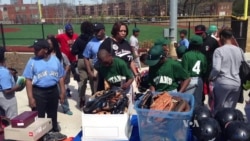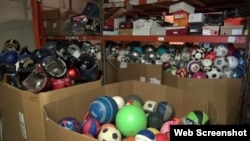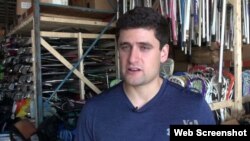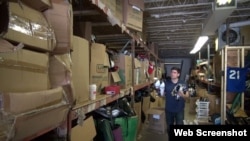On a field at a Washington elementary school, students hold soccer practice. They are in a free after-school program for youth in an underprivileged community.
Fourth grader Azaria Lee shows off her cleats and shin guards.
"I like playing soccer and it makes me happy when I play soccer,” she says.
Putting used equipment to good use
It's clear that playing a sport at a young age has many benefits.
But for low-income families that struggle to pay bills and put food on the table, sports equipment can be too expensive for their children.
Max Levitt saw the problem, and he believed no child should be denied playing sports because of the cost.
So he founded Leveling the Playing Field four years ago. The non-profit organization collects used sports equipment and puts it in the hands of those in need.
“I played every sport," Levitt says. " I was lucky enough that my family could afford to give me that opportunity. But it bothers me that there are thousands and thousands of kids every day who are unable to play sports because of the cost. That is really sad.”
Levitt used to work in college athletics and youth sports. There, he realized there was a simple solution.
Play with it again
"Every year, all of the sporting equipment that we were using in the previous season got thrown away. So I figured if there’s a huge waste of sporting equipment in America going on and there's an incredible need in our impoverished neighborhoods right around the corner. We got to do something about this,” says Levitt.
Levitt started collecting equipment in his parent’s basement. His operation now has grown to a 370-square-meter warehouse space. The giant boxes and tall shelves there are filled with thousands of baseball gloves and hats, soccer balls, cleats, hockey skate, helmets, lacrosse sticks, golf clubs and more.
"We have about $1.5 to $2 million worth of equipment in the warehouse," Levitt estimates.
He believes sports help lead children to a healthy lifestyle.
“First of all, in this country since the 1980s I think the obesity rates tripled," says Levitt. "This country is having a very hard time with healthy living, especially in our low-income areas.It's become a major issue for a lot of kids who are struggling to stay fit.”
Jerome Clemons is the soccer coach of DC SCORES, the non-profit organization that runs the free after-school program.
"Playing sports, youth sports particularly, is very important for youth development," says Clemons. "It helps you build character. It teaches you about teamwork. It gives them more of an opportunity to do activities after school rather than get in trouble.”
So far, Leveling the Playing Field has donated more than $1.4 million worth of sporting equipment to 300 different programs in the D.C.- Baltimore area, benefiting over 100,000 children.But Levitt says that would have been impossible without volunteers help. He has only two full-time staff members including him.
"We had over 500 volunteers in 2015. We rely heavily on the community. We have people come in here and sort out equipment for us, people run collection drives for us. There's no way we could have done this without the help of the youth sports community."
Levitt’s goal is to bring the program to other cities across the country and help every child enjoy playing sports as he did.









